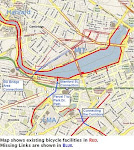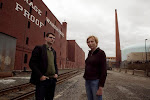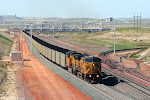 |
| Photo by Justin Franz | Flathead Beacon |
Unbeknownst to many here in the United States, our nation ”will surpass Russia and Saudi Arabia as the world’s top oil producer by 2015, and be close to energy independence in the next two decades, according to the International Energy Agency (IEA), a Paris-based adviser to 28 energy-consuming nations,” so writes William C. Vantuono in Railway Age Magazine. Largely this is due to increasing outputs of both crude oil and natural gas from shale formations in the United States.
Enabling the Latent Production Capacity
Much of this new capacity is made possible by hydraulic fracturing (“fracking”). The safety and environmental impacts of this process is worthy of its own lengthy consideration, so I will not digress to the discuss whether this is a good or bad path for the nation in this blog post.
 |
| The southern leg of the Keystone Pipeline in construction while controversy swirls around the norther segment. Photo by Daniel Acker/Bloomberg |
Nevertheless, while that discussion is ongoing, there is presently the dilemma of how to transport all this oil, while there is not sufficient pipeline capacity, with such proposals as the Keystone Pipeline raising its own environmental issues related to construction impacts as well as impacts of possible leaks once the pipeline is in service.
How is this gap between demand and transport capacity being met?
The Growth of Crude by Rail (CBR)
 |
| DOT-111 tank cars carry crude oil. Photo by Harvey Henkelmann |
The railroads have stepped in, allocating tank cars (typically of the DOT-111 specification). This type of tank car is plentiful in North America, as it constitutes 69% of the US tank car fleet and 80% of the Canadian tank cars. The avail-ability of these cars positioned the railroads to step in where the pipelines remained underdevelop-ment and wrapped in controversy.
Compared to fixed pipelines, CBR presents many inherent advantages:
- More nimble in meeting immediate demands, compared to the development time for a pipeline, which includes design, permitting, financing, constructing, testing, and commissioning, which can take well over a decade.
- Whereas a pipeline is a fixed asset between a fixed Point A and a fixed Point B, the railroads can respond to shifting locations of Points A and B.
Nevertheless, this option is not without risk. This is most vividly illustrated by the horrific runaway-train accident in Lac-Mégantic, Quebec, which resulted in a fire-ball that killed 47 and destroyed 30 buildings in the town. While the causes of this accident are many (and worthy of a separate blog post), it is the death and destruction that point to the volatility of the cargo and the risks inherent in CBR.
Risk Comparison: CBR and Pipelines
For CBR, the risks are both in leaks from railcars (without an accident) and in leaks and potential combustion resulting from an accident. With pipelines, the principal risk is in leaks.
When it comes to leaks, it appears that CBR has a better track record, in terms of spills per ton-mile between 2002 and 2012:
- railroads spilled 2.2 gallons of oil per million ton-miles
- pipelines spilled 6.3 gallons of oil per million ton-miles
Still, not all spills are equal. To assess risk, one needs to consider how to define the risks and how well the risks can be mitigated.
CBR travel on many rail routes and it is impossible to predict where the next spill will occur, be it at location where a spill is easily contained before damage to humans or the environment happens, or somewhere that the impacts are more significant. With a fixed pipeline, the higher risk locations are more easily definable and additional accommodations can be made. With railcars, in my opinion, you always have to consider a crash after a collision or derailment.
 |
| Double wall pipe |
In both cases, a first line of risk mitigation is containment. For a long time, fuel tanks and pipelines have been "doubled walled" or a pipe within a pipe. So, if the pipe or inner tanks springs a leak, the outer pipe or tank can contain the spill. Bot in both cases, there are other causes of spills that are more sudden and catastrophic.
Pipelines can be damaged by external forces, from a collision, accidental impact from construction equipment, earthquakes, or intentional damage from sabotage or terrorism. Pipelines under pressure can experience pressure surges that potentially could open up a joint. Various appurtenances (e.g., valves, branch connections, testing or sampling ports) are of differing construction and these items or the interface with the pipeline could be weak spot. While pipeline designers know all these risks and consider them, sometimes something can go wrong that was not anticipated or is due to operating the line in an improper manner.
Similar risk issues exist with railcars, and railcar designers can design cars with that in mind.
Making Tank Cars Safer
Admittedly, the DOT-111 is an old specification and needs to be updated. Granted much of today's fleet has been upgraded, according to Railway Age, "to AAR [Association of American Railroads] standards implemented in 2011. These standards include double hulls, energy-absorbing head (end) shields, recessed top valves, and shelf-type couplers that are less prone to detaching vertically (and thus puncturing a car) in a derailment." Nevertheless, the scene in Lac-Mégantic was so horrific, it would be impossible to stay the status-quo on tank car design.
In November, I was pleasant-ly surprised when the AAR, which is the association of the railroads, proactively came out in favor of stronger regulation of its own industry, specifically in regard to the design of tank cars. As reported in Railway Age, "The Association of American Railroads (AAR) on Thursday, Nov. 14, 2013, urged the U.S. Department of Transportation 'to press for improved federal tank car regulations by requiring all tank cars used to transport flammable liquids to be retrofitted or phased out, and new cars built to more stringent standards.' In comments filed with the Pipeline and Hazardous Materials Safety Administration (PHMSA), AAR said the safety upgrades it recommends will substantially decrease the likelihood of a release if a tank car is involved in an accident."
This is a positive step forward.
The Future of CBR
While I and many others would like to see more renewable and cleaner energy sources linked with energy conservation, we will not get to that future day magically and overnight. In the interim, our nation runs on energy and the economics of domestic oil production will drive the demand for transporting crude oil from the wells to the refineries.
Will the energy industry wait for the pipeline capacity to be increased?
They simply can't wait that long.
Are the politicians that think the Keystone Pipeline is a key to our energy self-sufficiency about 10 years behind the times?
You bet! (As are other fossils in DC who think there is any future in coal!)
Will better tank cars prevent any future spill?
No one can promise there won't be another oil spill, but safer tank cars is a good step for now. Only when we move completely away from oil as a fuel will we end oils spills for good.
Is CBR here to stay?
Unlikely. But count it in for the next decade, at least.





